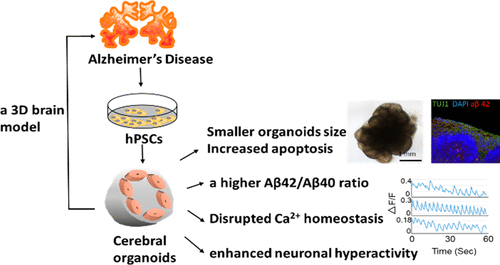当前位置:
X-MOL 学术
›
ACS Biomater. Sci. Eng.
›
论文详情
Our official English website, www.x-mol.net, welcomes your
feedback! (Note: you will need to create a separate account there.)
Enhanced Neuronal Activity and Asynchronous Calcium Transients Revealed in a 3D Organoid Model of Alzheimer’s Disease
ACS Biomaterials Science & Engineering ( IF 5.4 ) Pub Date : 2020-12-21 , DOI: 10.1021/acsbiomaterials.0c01583 Juan Yin 1 , Antonius M. VanDongen 1
ACS Biomaterials Science & Engineering ( IF 5.4 ) Pub Date : 2020-12-21 , DOI: 10.1021/acsbiomaterials.0c01583 Juan Yin 1 , Antonius M. VanDongen 1
Affiliation

|
Advances in the development of three-dimensional (3D) brain organoids maintained in vitro have provided excellent opportunities to study brain development and neurodegenerative disorders, including Alzheimer’s disease (AD). However, there remains a need to generate AD organoids bearing patient-specific genomic backgrounds that can functionally recapitulate the key features observed in the AD patient’s brain. To address this need, we described a strategy to generate self-organizing 3D cerebral organoids which develop a functional neuronal network connectivity. This was achieved by neuroectoderm induction of human pluripotent stem cell (hPSCs) aggregates and subsequent differentiation into desired neuroepithelia and mature neurons in a 3D Matrigel matrix. Using this approach, we successfully generated AD cerebral organoids from human pluripotent stem cells (hPSCs) derived from a familial AD patient with a common mutation in presenilin 2 (PSEN2N141I). An isogenic control with an identical genetic background but wild-type PSEN2 was generated using CRISPR/Cas9 technology. Both control and AD organoids were characterized by analyzing their morphology, the Aβ42/Aβ40 ratio, functional neuronal network activity, drug sensitivity, and the extent of neural apoptosis. The spontaneous activity of the network and its synchronization was measured in the organoids via calcium imaging. We found that compared with the mutation-corrected control organoids, AD organoids had a higher Aβ42/Aβ40 ratio, asynchronous calcium transients, and enhanced neuronal hyperactivity, successfully recapitulating an AD-like pathology at the molecular, cellular, and network level in a human genetic context. Moreover, two drugs which increase neuronal activity, 4-aminopyridine (4-AP) and bicuculline methochloride, induced high-frequency synchronized network bursting to a similar extent in both organoids. Therefore, our study presents a promising organoid-based biosystem for the study of the pathophysiology of AD and a platform for AD drug development.
中文翻译:

增强的神经元活动和异步钙瞬变在阿尔茨海默氏病的3D人体模型中揭示
体外维持的三维(3D)脑类器官的开发进展为研究大脑发育和神经退行性疾病(包括阿尔茨海默氏病(AD))提供了极好的机会。然而,仍然需要产生带有患者特异性基因组背景的AD类器官,其可以在功能上概括在AD患者的大脑中观察到的关键特征。为了满足这一需求,我们描述了一种生成自组织3D脑器官的策略,该3D脑器官可以发展功能性神经网络连接。这是通过神经外胚层诱导人多能干细胞(hPSC)聚集体并随后在3D Matrigel基质中分化为所需的神经上皮和成熟神经元来实现的。使用这种方法,N141I)。使用CRISPR / Cas9技术生成了具有相同遗传背景但野生型PSEN2的同基因对照。通过分析它们的形态,Aβ42/Aβ40比率,功能性神经元网络活性,药物敏感性和神经细胞凋亡的程度来表征对照和AD类器官。网络的自发活动及其同步是通过钙成像在类器官中测量的。我们发现,与经突变校正的对照类器官相比,AD类器官具有更高的Aβ42/Aβ40比,异步钙瞬变和增强的神经元过度活跃,从而成功地概括了人类在分子,细胞和网络水平上的类AD病理遗传背景。此外,增加神经元活性的两种药物是4-氨基吡啶(4-AP)和双小分子甲氯化物,感应的高频同步网络在两个类器官中都以相似的程度爆发。因此,我们的研究提出了一种有前途的基于类器官的生物系统,用于研究AD的病理生理学和AD药物开发的平台。
更新日期:2021-01-11
中文翻译:

增强的神经元活动和异步钙瞬变在阿尔茨海默氏病的3D人体模型中揭示
体外维持的三维(3D)脑类器官的开发进展为研究大脑发育和神经退行性疾病(包括阿尔茨海默氏病(AD))提供了极好的机会。然而,仍然需要产生带有患者特异性基因组背景的AD类器官,其可以在功能上概括在AD患者的大脑中观察到的关键特征。为了满足这一需求,我们描述了一种生成自组织3D脑器官的策略,该3D脑器官可以发展功能性神经网络连接。这是通过神经外胚层诱导人多能干细胞(hPSC)聚集体并随后在3D Matrigel基质中分化为所需的神经上皮和成熟神经元来实现的。使用这种方法,N141I)。使用CRISPR / Cas9技术生成了具有相同遗传背景但野生型PSEN2的同基因对照。通过分析它们的形态,Aβ42/Aβ40比率,功能性神经元网络活性,药物敏感性和神经细胞凋亡的程度来表征对照和AD类器官。网络的自发活动及其同步是通过钙成像在类器官中测量的。我们发现,与经突变校正的对照类器官相比,AD类器官具有更高的Aβ42/Aβ40比,异步钙瞬变和增强的神经元过度活跃,从而成功地概括了人类在分子,细胞和网络水平上的类AD病理遗传背景。此外,增加神经元活性的两种药物是4-氨基吡啶(4-AP)和双小分子甲氯化物,感应的高频同步网络在两个类器官中都以相似的程度爆发。因此,我们的研究提出了一种有前途的基于类器官的生物系统,用于研究AD的病理生理学和AD药物开发的平台。









































 京公网安备 11010802027423号
京公网安备 11010802027423号